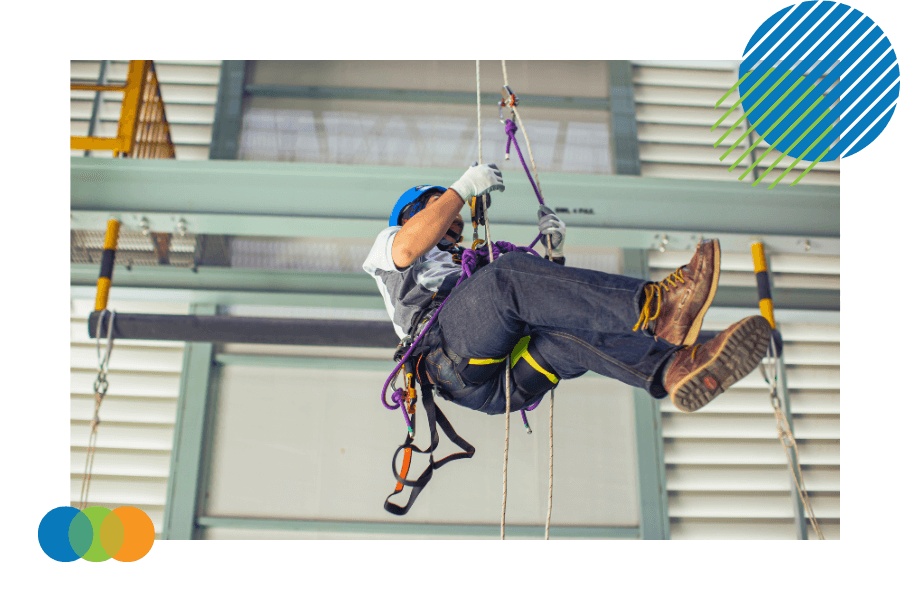 |
Written by Liz McDermott |
The numbers tell a sobering story: one-third of all construction fatalities happen when workers fall to a lower level. More troubling still, 90% of these deaths occur because no fall protection system exists.
Real people, real tragedies. Each statistic represents a preventable workplace accident. OSHA's rules include the following: Workers need fall protection when working at heights of four feet in general industry and six feet in construction.
Personal Fall Arrest Systems play a vital role in workplace safety. These systems must hold 5,000 pounds and stop falls before six feet. But equipment alone won't keep workers safe. Proper training can mean the difference between life and death, making an online working with heights course an effective solution for reducing risks.
Safety managers across the United States and Canada, this guide speaks to you. We'll walk through fall protection training essentials and show you practical, budget-friendly online options to protect your workers because every life saved matters.

Understanding Fall Protection Fundamentals
Let's simplify fall protection and focus on what matters most: keeping workers safe. Every walking or working surface poses a potential fall hazard.
Think of fall protection like a chain - it's only as strong as these four essential links:
- Anchorage: Your lifeline needs a solid foundation - it must support 5,000 pounds per worker attached
- Body Support: A full-body harness spreads fall forces across your most substantial parts - thighs, pelvis, and chest
- Connectors: These crucial pieces link your harness to anchor points
- Descent/Rescue: Your backup plan when things go wrong
OSHA fall protection training spells out exactly when you need fall protection. Here's what you should know:
Industry Sector |
Required Height |
|---|---|
| General Industry | 4 feet or higher |
| Shipyards | 5 feet or higher |
| Construction | 6 feet or higher |
| Longshoring | 8 feet or higher |
Smart safety starts with eliminating hazards, which fall protection online training can help you achieve without breaking your safety training budget. Before relying on protective equipment, look for ways to change your workspace or processes. Remember this sobering fact: falls from heights of 10 feet or greater almost always lead to serious injury or death.
Your safety net needs two layers. Passive systems, like guardrails, work silently in the background. Active systems, like personal protective equipment, need your engagement and proper training to work effectively.
Essential Working at Heights Training Components
Safety equipment only works when you know how to use it. That's why proper training zeros in on the three pillars of a Personal Fall Arrest System: your anchor point, connector, and full-body harness.
Here's what your training should cover:
Training Element |
Key Focus Areas |
|---|---|
| Equipment Selection | Proper sizing and compatibility |
| Inspection Procedures | Pre-use checks and maintenance |
| Harness Fitting | Correct adjustment and positioning |
| Emergency Response | Rescue procedures and protocols |
Think of equipment checks like your morning coffee - they should happen every day without fail. A competent person needs to look deeper at least every six months. Your employer keeps these records - it's not just good practice. It's the law.
Your harness needs to fit like a glove. A loose harness might prevent a fall but also cause injuries. The dorsal D-ring belongs between your shoulder blades. This sweet spot helps distribute forces across your strongest areas.
Time matters in emergencies. OSHA requires workers to be rescued within 4-6 minutes of a fall. Your rescue plan can't be a rough draft - it needs clear steps before, during, and after a rescue.
Implementing Effective Fall Protection Classes
Let's talk about fall protection class levels. Like climbing a ladder, each step takes you higher in expertise and responsibility.
Training Level |
Purpose |
|---|---|
| Awareness Level | Basic hazard recognition |
| Authorized User | Equipment operation |
| Competent Person | Site supervision |
| Qualified Person | System design |
You can choose your path based on your workplace role. For example, if you want to oversee job sites and run annual equipment checks, you'll need Competent Person certification.
Virtual training has found its footing, too. These aren't your typical snooze-worthy webinars - they're live sessions with real interaction and small class sizes. You'll need:
- One fall protection harness and lanyard (because theory only gets you so far)
- Multiple monitors (the more you see, the more you learn)
- Practical exercises for spotting hazards
Book learning is insufficient. Your hands need to know what they're doing. We advocate for practical exercises like actual equipment, real inspections, and accurate fit testing.
Certifications expire after two years. Think of them as a subscription to safety. Regular refreshers keep you sharp and OSHA-happy.
Conclusion
Fall protection isn't just another safety checklist item. Those construction fatality numbers we discussed remind us why mastering the basics matters: anchorage, body support, connectors, and descent systems.
Good training sticks. Whether you learn in a classroom or through your screen, you'll walk away knowing how to inspect gear, fit a harness correctly, and handle emergencies. Want to build a stronger safety culture without breaking the bank? Consider a Vubiz's online fall protection course:
Here's the thing about fall protection - it's not about dodging OSHA fines. It's about making sure everyone goes home at night. Keep your certifications fresh, get your hands dirty with practice, and know those safety protocols cold. Because at the end of the day, a safer workplace isn't just good business - it's good people looking out for each other.
